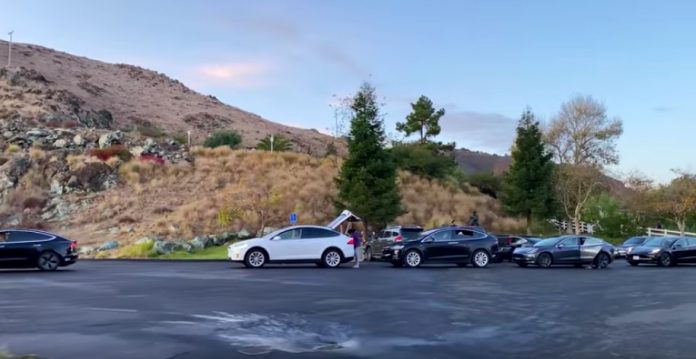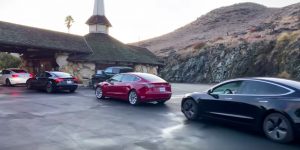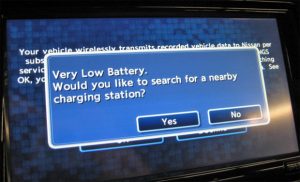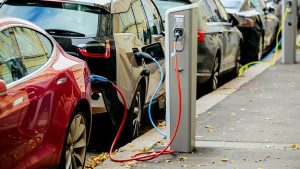Guest Post by Eric Peters

There was an interesting story over the holiday about electric cars piled up at “fast” chargers . . . waiting in line for other EVs to finish “fast” charging. This brings up the problem of throughput – another of many EV problems not being reported by the general press as well as the car press (the latter being inexcusable).
It is a function of the EV’s much longer recharge time vs. a non-electric car’s time to refuel. Even in a best-case scenario – at what are hilariously (and depressingly) styled “fast” chargers – an EV takes at least five times as long (about 30 minutes) to recover a partial charge as it takes to fully refuel a non-electric car.
Consider what this means in terms of how many electric cars can recharge in one hour at a limited number of “pumps.”
A gas station that has say six gas pumps can refuel six cars in about five minutes but for the sake of discussion, call it ten each – to take into account people leaving their car at the pump for a couple of minutes longer than it takes to fill up to go inside to buy a soda, etc. The station’s throughput at that rate is six cars every ten minutes. Twelve cars in 20; 36 cars in an hour.
But six EV “fast” chargers can only charge six cars – partially – in 30 minutes. In the same one hour that it takes to refuel 36 cars, only 12 EVs are partially recharged. This being necessary at a “fast” charger, to avoid damaging the very expensive battery and shortening its already short useful life. The EV can only accept about 80 percent “fast” charge; the remainder has t be charged slowly. Well, even more slowly. The full charge takes an hour-plus – but let’s leave that problem aside for purposes of this discussion.
The EV leaves the “fast” charger with 80 percent charge.
Which means it’ll have to be recharged again, sooner.
That’s the best-case scenario, remember.
The only way to mitigate this – in terms of the number of EVs that can charge at the same time – would be to build at least three times as many “fast” chargers as there are gas pumps. But where will the money come from? And where will the space come from?
Six pumps fit easily on a small concrete pad. But it would take the equivalent of three times as much space to match the gas station’s throughput capacity with EV “fast” chargers. This means a tripling of real estate and construction costs to the owner of the “fast” charge” station. More waste, too – of concrete and steel and all the other material which go into building a gas – or EV – station.
What is the carbon footprint of all this, by the way?
Of course, ordinary parking spots could be converted to “fast” charging spots, thereby eliminating the problem of having to find three times the space for new EV charging stations.
But you’d still have to wait the 30 minutes vs. five or less.
And then parking throughput becomes a problem. Because there’s no getting around the limited number of parking spots – and places available to build new ones. The curbside real estate in most urban areas is already spoken for; finding a place to park in most such areas is often difficult as it is.
What happens when you need more than a place to park?
Your EV is running low on charge – but all the “fast” charging spots are full. And – unless the laws are changed – many of those cars occupying those “fast” curbside charging spots are also parked there. Their owners aren’t waiting to get back on the road again. They are eating dinner, shopping . . . or in for the night.
If you run out of charge before you find a place to recharge, your EV will brick – in the middle of a busy city street, perhaps. And when that happens, you will have to get your EV towed to a “fast” charger . . . when one becomes available. Kilowatt-hours not being transportable in a jerry can, like gasoline.
More waiting.
City traffic is already chaotic and stressful. Imagine what it will be like when thousands of EVs are jockeying for limited places to charge-park and regularly bricking in the middle of the road because someone ran out of juice before they could get more juice.
Imagine what it will be like when, in addition to circling the block over and over in the hope that a spot will open up, you have to sweat the needle – the battery charge needle.
It’s a non-worry for non-electric car owners. Even if they do run out of gas, getting back on the road is easy – and quick. Gasoline being transportable in a jerry can. 
No waiting.
Perhaps new multi-story EV parking/charging lots will be built. Less waiting . . . for the hook up, at least.
But who will pay for this? And who will pay for the efficiency cost? In terms of time wasted? A single multi-story “fast” charging building will only be convenient for a relative handful of people, those who happen to live/work/shop near it. Those who don’t will have to spend more time getting to where they need to be after they leave their EV.
If the distance is too far to be reasonably traversed on foot, then what? Will new train routes be added? EV buses built? Who will pay for all of that? And even if the money available were limitless – which EV people seem to believe it is – time is precious. More of it cannot be purchased, even with limitless funds.
This will be another price of our Electric Car Future.
Why anyone is interested in paying it escapes me.
It is my sincere desire to provide readers of this site with the best unbiased information available, and a forum where it can be discussed openly, as our Founders intended. But it is not easy nor inexpensive to do so, especially when those who wish to prevent us from making the truth known, attack us without mercy on all fronts on a daily basis. So each time you visit the site, I would ask that you consider the value that you receive and have received from The Burning Platform and the community of which you are a vital part. I can't do it all alone, and I need your help and support to keep it alive. Please consider contributing an amount commensurate to the value that you receive from this site and community, or even by becoming a sustaining supporter through periodic contributions. [Burning Platform LLC - PO Box 1520 Kulpsville, PA 19443] or Paypal
-----------------------------------------------------
To donate via Stripe, click here.
-----------------------------------------------------
Use promo code ILMF2, and save up to 66% on all MyPillow purchases. (The Burning Platform benefits when you use this promo code.)







Who will pay for this? Surely you jest.
That’s why the Prius model with the backup charging motor makes more sense. You have a choice about buying an electric car(for now) Think of all those nice cars from the seventies, large and comfy. Do you see any on the road now? Things change and not always for the good.
I fohnd a chevy c10 daily driver 2wd in great shape with an 8ft bed for only 6000 bucks.
Very good points all. Then look at the situation a owner of an EV will be in when lets say………. five years into ownership and he / she realizes the EV needs it’s battery replaced. Faced with a high cost of replacement for the battery they will probably just put the money toward a down payment on a new car, hopefully a IC car, which I think they will be more than ready for. I’ve only seen a couple of Tesla’s in the central Arkansas area as I think most people here are smarter than to buy a POS like a Tesla. Like Eric has said, if they were an economically viable product then people would be lined up for them like they did the Model T’s.
Lot’s of dumb shits in Dallas then. They are probably hitting 1% of the cars on the road here.
Those cars were doing their part to control GW while posing at the roadside. I drove to Colorado Springs and back to St. Louis for Thanksgiving. No more than 10 minutes to refuel at any stop. God bless the man who invented internal combustion engines.
No one is actually paying the true cost of ev purchase and ownership at present – it’s all subsidized – by fiat debt.
Its worth it though. You can save up to 500 follars a year with an electric over a gas car, and, model dependant, a tesla will pay for itself in as few as 100 years.
All the utopia people who think that the world would be a better place if everyone rode public transit or, if they absolutely had to drive, drove an EV ignore one factor: TIME.
Taking a bus or walking or riding a bike or driving an EV that requires 30 minutes to charge all make getting from point A to point B a much longer excursion then if an IC vehicle was used. That is why IC cars are the most popular means of transportation. They get you from where you are to where you want to go in a minimum amount of time.
Why is that so difficult for the utopia people to understand.
Fyi. As far as facts go, my Tesla is currently five years old and still has about 85% of the original battery capacity.
And I charge my car at home 99% of the time. Almost everyone that has an electric car charges their car at home at night.
The fast charging is only for traveling out of town or forgetting to charge the car.